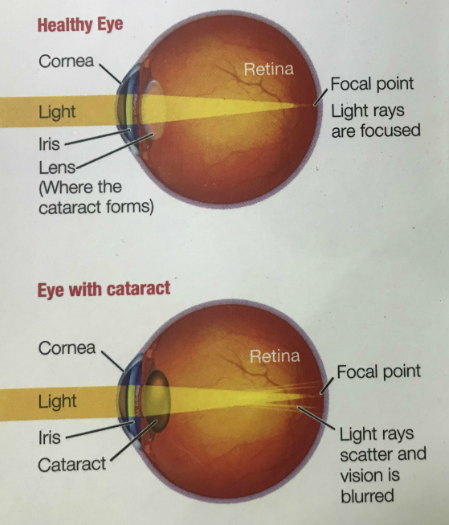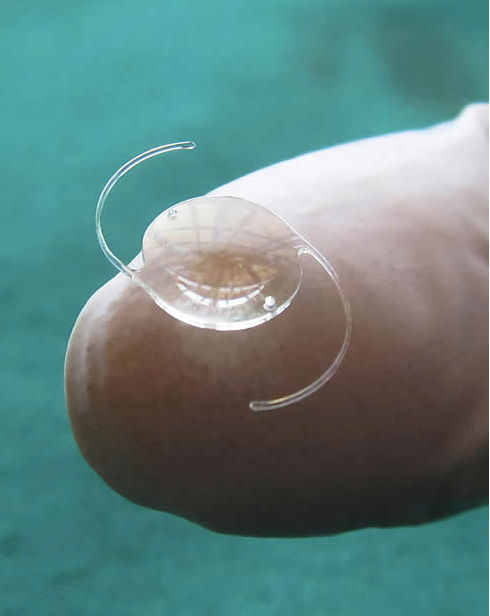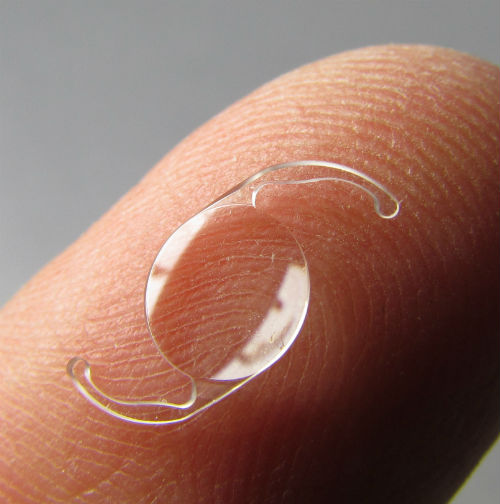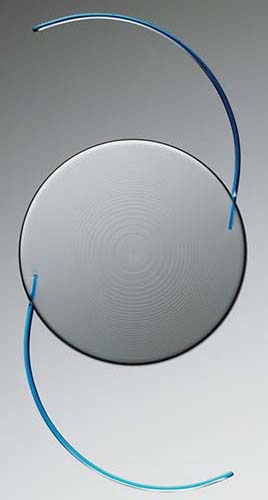CATARACT(सफ़ेद मोतिया)
Inside our eyes, we have a natural lens. The lens bends (refracts) light rays that come into the eye to help us see. The lens should be clear. If you have a cataract, your lens has become cloudy. It is like looking through a foggy or dusty car windshield. Things look blurry, hazy or less colorful with a cataract.
हमारी आंखों के अंदर एक प्राकृतिक लेंस है। लेंस प्रकाश किरणें जो आंखों में आती हैं जो हमें देखने में मदद करती हैं उन्हें झुकाता है (अपवर्तित) । लेंस स्पष्ट होना चाहिए। यदि आपको मोतियाबिंद है, तो आपका लेंस दूधिया हो गया है। यह एक धूमिल या धूल भरी कार विंडशील्ड के माध्यम से देखने जैसा है। मोतियाबिंद के साथ चीजें धुंधली, धुंधला या कम रंगीन दिखती हैं।
Why Cataract occurs?
सफ़ेद मोतिया क्यों होता है ?
Aging is the most common cause. This is due to normal eye changes that happen starting around age 40. That is when normal proteins in the lens start to break down. This is what causes the lens to get cloudy. People over age 60 usually start to have some clouding of their lenses. However, vision problems may not happen until years later.
Other reasons you may get cataracts include:
- having certain medical problems, such as diabetes
- having had an eye injury, eye surgery, or radiation treatments on your upper body
SYMPTOMS
- Having blurry vision
- Seeing double (when you see two images instead of one)
- Being extra sensitive to light
- Having trouble seeing well at night, or needing more light when you read
- Seeing bright colors as faded or yellow instead

What is the treatment?
Cataract Surgery is the best treatment of cataract. Cataract surgery involves removing the clouded lens and replacing it with a clear artificial lens. The artificial lens, called an intraocular lens, is positioned in the same place as your natural lens. It remains a permanent part of your eye.
For some people, other eye problems prohibit the use of an artificial lens. In these situations, once the cataract is removed, vision may be corrected with eyeglasses or contact lenses.
Cataract Lenses Available At Manocha Eye Hospital

This type of lens replacement will let you see very clearly, but only at one distance. So if you choose to have a lens to improve your vision to help with short-sightedness, you may still need to wear glasses to see clearly at a distance, and vice versa.
There are three different distances, and the one that you want to improve will depend on what you do on a daily basis
There are three different distances, and the one that you want to improve will depend on what you do on a daily basis
- Long distant vision – if you drive for a living, then improving your long distance vision could help immensely. This could also be a good choice if you like to watch a lot of television, or if you are a keen golf player.
- Intermediate vision – this type of distance is similar to the distance that you would view a computer screen from. If you work in an office job, and have to spend a large portion of your day looking at a screen, you may well benefit from improving your middle distance vision. You may have noticed in the past that you suffer from headaches at the end of a long working day, and if this is the case for you then improving this vision could decrease the number of headaches you have.
- Near Vision – if you like to read a lot, then improving your short distance vision could be a good option for you. This may be beneficial if you spend a lot of time reading paper documents for work.

If you have astigmatism(cornea or lens develops into an irregular shape), this type of lens replacement will improve your vision at one specific distance. You may find that astigmatism blurs your vision slightly, so choosing to have this issue fixed with a toric lens could be beneficial to you.

A multifocal lens replacement will help to improve your vision at a number of different distances, and could be helpful if you are constantly switching distances during the day.
For example, if you need to switch from making notes on paper in front of you, to looking at your screen, then on to looking at a presentation at the front of the room, you will want to be able to do so without having to change your glasses each time.
Myths / Frequently Asked Questions
1MYTH: PEOPLE WHO TAKE CARE OF THEIR EYES WON’T GET CATARACTS.
Fact: Everyone will get cataracts as they get older. In fact, aging is the most common cause of cataracts. They can also be caused by trauma, some medications, systemic diseases like diabetes, and prolonged exposure to ultraviolet light. While you can do some things to delay cataracts – like wearing sunglasses to protect your eyes from ultraviolet light – you can never completely prevent them.
2MYTH: MY EYES DON’T HURT, SO I DON’T HAVE CATARACTS.
Fact: Cataracts usually do not cause pain. Instead, they cause blurred vision, double vision, glare, discoloration, and frequent changes in your glasses prescription.
3MYTH: CATARACTS ONLY AFFECT THE ELDERLY.
Fact: Cataracts can affect children and young adults as well as the elderly. Heredity, disease, eye injury, and smoking are contributing factors. As people age, they can start showing signs of cataracts as early as 40.
4MYTH: CATARACT SURGERY IS DANGEROUS
Fact: Cataract surgery is incredibly safe and effective.
5MYTH: CATARACT SURGERY IS TIME-CONSUMING.
Fact:Cataract surgery only takes about 10 minutes, and recovery time usually takes no more than an hour. You will, however, still need someone to drive you home after your procedure and you’ll be given a pair of sunglasses to wear on the way home to protect your eyes.
6MYTH: THE REPLACEMENT LENS MIGHT NOT BE GOOD FOR MY EYE.
Fact: A wide variety of replacement lenses is available to restore your vision. Options may include implants that correct for distance, intermediate and near vision as well as astigmatism. While there is no way to test a lens before it is implanted, your lifestyle and eye health can help you determine which lens would be best for you. Your doctor will discuss your options with you before your surgery.
7CAN I GET IOLS WITH PRISM CORRECTION?
Question:
I am 70 years old and have had prescription glasses with prisms for double vision for almost 50 years. I have very slight cataracts that do not require surgery now. However, could I have lens replacement surgery with lenses that have prisms?
Answer: Unfortunately, there are no intraocular lenses (IOLs) that have prism in them. Depending on how much prism you have, eye muscle surgery can eliminate the need for prism in some cases.
Answer: Unfortunately, there are no intraocular lenses (IOLs) that have prism in them. Depending on how much prism you have, eye muscle surgery can eliminate the need for prism in some cases.
8WILL SECONDARY CATARACT SURGERY WORSEN MY AMD?
Question:
Will a laser procedure on a secondary cataract possibly worsen macular degeneration?
Answer: There is little evidence to suggest that correcting a secondary cataract with laser (posterior capsulotomy) can make your AMD (age-related macular degeneration) worse. Your visual improvement from the laser could be limited by the AMD, but the laser is not likely to worsen the AMD.
Answer: There is little evidence to suggest that correcting a secondary cataract with laser (posterior capsulotomy) can make your AMD (age-related macular degeneration) worse. Your visual improvement from the laser could be limited by the AMD, but the laser is not likely to worsen the AMD.
9DOES CATARACT SURGERY WITH NEARSIGHTEDNESS HAVE HIGHER RISK OF RETINAL PROBLEMS?
Question:
I am nearsighted and have a preexisting posterior vitreous detachment (PVD) and floaters in both eyes. Does cataract surgery carry a higher risk of retinal detachment, more PVD, and/or an increase in the floaters?
Answer: Although cataract surgery does increase your risk for a retinal detachment, this risk is still fairly low, as less than 1% of cataract surgeries lead to retinal detachment. The risk is greater if you are young, male, nearsighted (myopia) or if you have not had a posterior vitreous detachment (PVD). A pre-existing PVD decreases your risk but does not eliminate it. Floaters normally increase with age and following a PVD. With a pre-existing PVD, cataract surgery may allow the floaters to be seen more clearly but usually will not cause an increase in the number of floaters.
Answer: Although cataract surgery does increase your risk for a retinal detachment, this risk is still fairly low, as less than 1% of cataract surgeries lead to retinal detachment. The risk is greater if you are young, male, nearsighted (myopia) or if you have not had a posterior vitreous detachment (PVD). A pre-existing PVD decreases your risk but does not eliminate it. Floaters normally increase with age and following a PVD. With a pre-existing PVD, cataract surgery may allow the floaters to be seen more clearly but usually will not cause an increase in the number of floaters.
10CAN YAG LASER DISTURB A TORIC LENS AFTER CATARACT SURGERY?
Question:
Can a YAG capsulotomy (using laser to clear the cloudy capsule that holds your artificial lens) disturb a toric lens’s rotation or axis after cataract surgery over 6 months ago?
Answer: No, the intraocular lens should be firmly positioned inside the lens capsule and this should not be a problem.
Answer: No, the intraocular lens should be firmly positioned inside the lens capsule and this should not be a problem.
11CAN CATARACT SURGERY BE DONE WITHOUT SEDATION?
Question:
My wife cannot have any sedation. Can she have cataract surgery without sedation? She has had other eye procedures performed with only local anesthesia.
Answer: Cataract surgery is usually done with local/topical (eye drops) anesthesia. She may have some slight discomfort at the beginning of the surgery, but many patients decide to have no intravenous (given into the vein) sedating medications.
Answer: Cataract surgery is usually done with local/topical (eye drops) anesthesia. She may have some slight discomfort at the beginning of the surgery, but many patients decide to have no intravenous (given into the vein) sedating medications.
